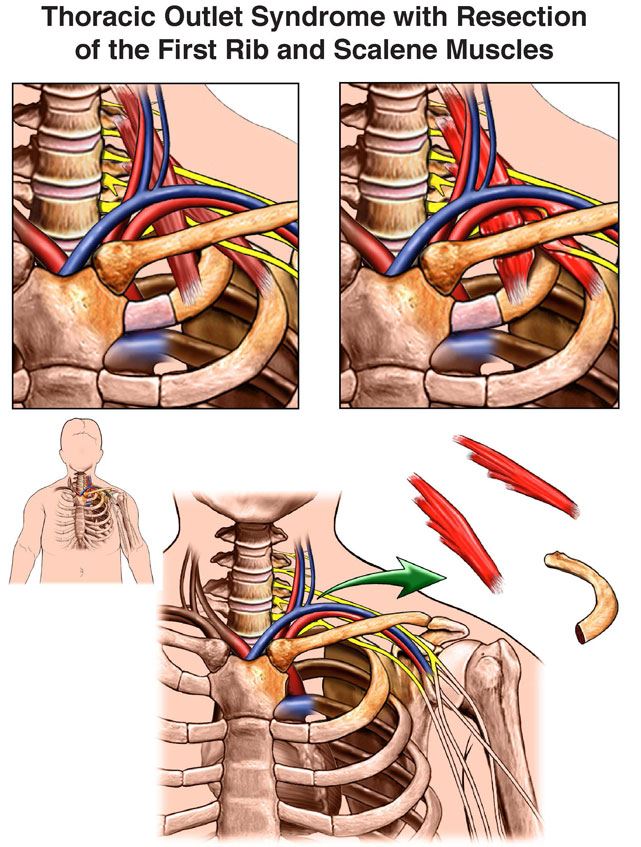Thoracic Outlet Syndrome (TOS)
A Detailed Overview
Thoracic Outlet Syndrome (TOS) represents a spectrum of disorders characterized by the compression of nerves, arteries, and/or veins within the thoracic outlet — the space extending from the lower neck to the armpit. This condition primarily affects the neurovascular structures leading to the upper limbs, presenting a range of symptoms based on the specific elements compressed.

Understanding TOS
TOS predominantly impacts healthy, young, and active individuals and is more often linked to physical trauma, overuse, or injury rather than congenital or disease processes. It’s a treatable condition with typically no lasting effects when addressed promptly and appropriately.
Causes of TOS
TOS can arise from various factors, including:
- Nerve Compression: The most common form, presenting with pain, weakness, and muscle atrophy at the thumb base.
- Venous Compression: Leads to swelling, pain, and possibly a bluish coloration of the arm.
- Arterial Compression: Results in arm pain, coldness, and paleness.
Triggers for these compressions include trauma, repetitive arm movements, congenital abnormalities (like a cervical rib), tumors, and pregnancy.
Symptoms of TOS
Manifestations of TOS vary widely but commonly include:
- Numbness or tingling in the arm and hand
- Arm pain that can be sharp, burning, or aching
- Worsened pain with arm lifting or repetitive movements
- An easily fatigued and weak arm
- In venous and arterial types, additional symptoms like hand coldness, arm bluishness, swelling, and paleness may occur
- Rarely, sores on fingers resistant to healing and gangrene can develop due to prolonged constriction


Impact on Health
While generally treatable with no long-term effects, untreated TOS can lead to serious complications like deep vein thrombosis (DVT) or pulmonary embolisms if blood clots form and migrate within the body.
Diagnosing TOS
Diagnosis involves a combination of stress maneuver testing, imaging studies like CT scans or MRIs, and catheter-based arteriography or venography. Anesthetic block injections may also be used to temporarily relieve symptoms and assist in diagnosis.

Treatment Options for TOS
Conservative Management
Includes advice on anticoagulation/platelet medications for venous or arterial TOS to manage or prevent blood clots.
Surgical Interventions
- First Rib Excision: Involves removing the cervical rib (uppermost rib) under general anesthesia through an incision in the armpit, neck, or near the collarbone to relieve compression. This procedure may also entail removing the anterior scalene muscle if it contributes to compression.
- Arterial Bypass: For arterial TOS, thoracic outlet decompression may include an arterial bypass to restore normal blood flow. This surgery bypasses damaged or compressed arteries with a synthetic or natural graft under general anesthesia.
Conservative Management
Includes advice on anticoagulation/platelet medications for venous or arterial TOS to manage or prevent blood clots.
Surgical Interventions
- First Rib Excision: Involves removing the cervical rib (uppermost rib) under general anesthesia through an incision in the armpit, neck, or near the collarbone to relieve compression. This procedure may also entail removing the anterior scalene muscle if it contributes to compression.
- Arterial Bypass: For arterial TOS, thoracic outlet decompression may include an arterial bypass to restore normal blood flow. This surgery bypasses damaged or compressed arteries with a synthetic or natural graft under general anesthesia.

Living with TOS
Post-diagnosis, it’s crucial to avoid repetitive stress on the affected limb and maintain a healthy lifestyle, incorporating physical exercise to manage and mitigate symptoms effectively.
Conclusion
TOS, while potentially debilitating, is a manageable condition with a broad spectrum of treatment options ranging from conservative management to surgical intervention, depending on the severity and type of compression involved. Early diagnosis and tailored treatment are key to preventing long-term complications and ensuring quality of life for those affected.
